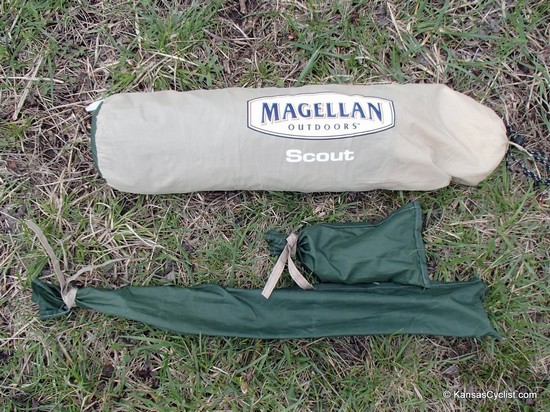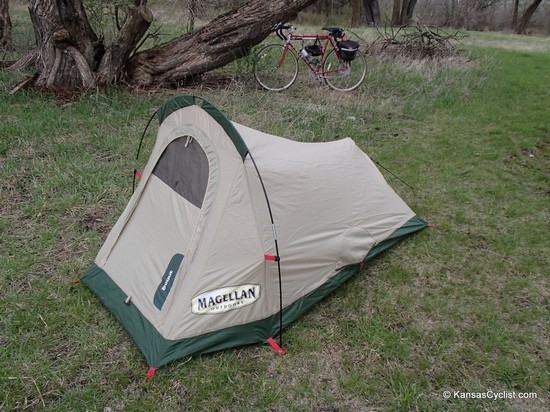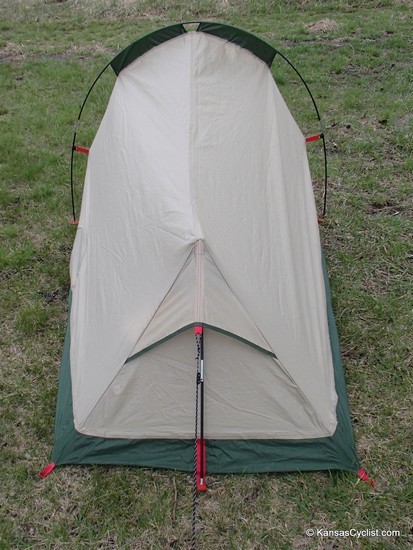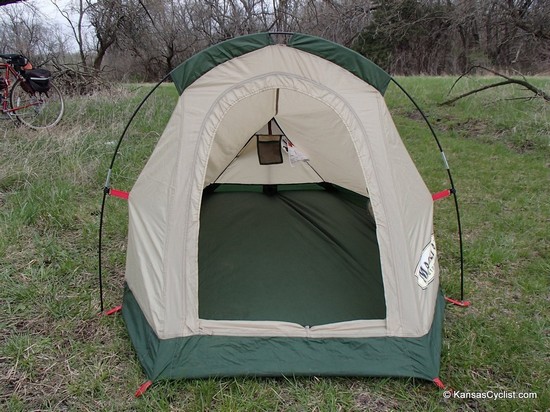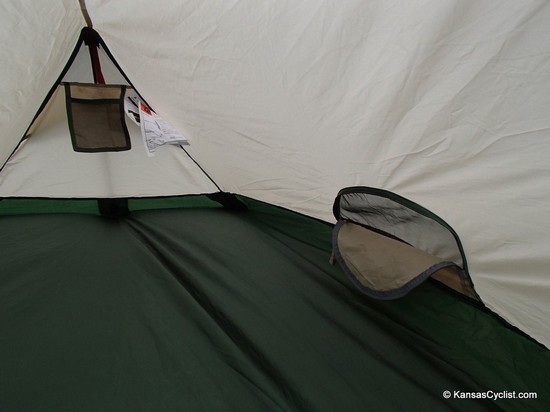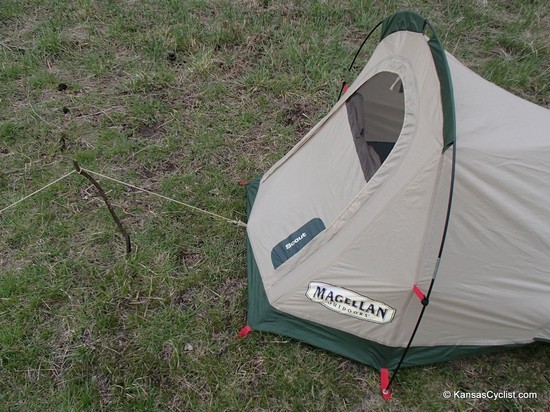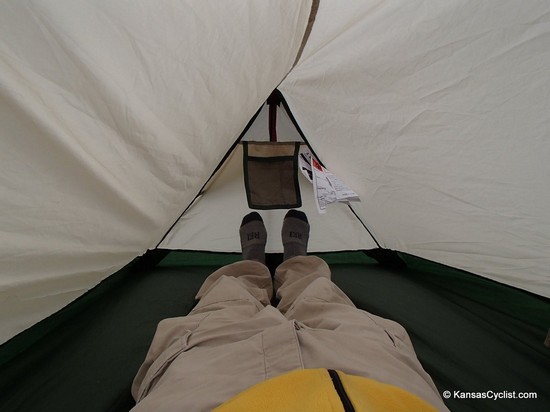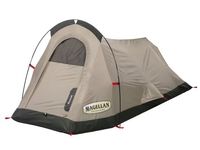 This is a review of the Magellan Scout Technical Tent, a small, one-person, lightweight tent for bicycle touring or backpacking. It is manufactured and sold by Academy Sports + Outdoors, a outdoor gear retailer, with stores primarily in the southern United States, but a growing presence in Kansas, with a store in Wichita, and additional retail outlets planned (as of 2013) for Olathe and Overland Park.
This is a review of the Magellan Scout Technical Tent, a small, one-person, lightweight tent for bicycle touring or backpacking. It is manufactured and sold by Academy Sports + Outdoors, a outdoor gear retailer, with stores primarily in the southern United States, but a growing presence in Kansas, with a store in Wichita, and additional retail outlets planned (as of 2013) for Olathe and Overland Park.
"Magellan Outdoors™" is an Academy® store house brand.
Review
I purchased the Magellan Scout Technical Tent in late 2012. The big selling points for the tent are a low price (about $25 list) and light weight (about 2.5 pounds). I was looking for a tent that would be more suitable for cold-weather bike camping than my larger Eureka Pinnacle Pass 2XTA, under the theory that a smaller tent with less mesh would retain body heat better than a larger, more ventilated tent.
The Magellan Scout Technical Tent is indeed small, with specifications of 82-inches in length, 36 inches peak height, and just enough width to accommodate one person and a small bit of gear.
It's a single-wall tent, meaning that there is no separate fly. There is only a small bit of mesh in the peak at the foot of the tent, a mesh area at the top of the single door (that can be sealed with a zippered flap), and a small mesh window along the bottom of one side (that can also be sealed with a zippered flap).
The tent is not free-standing. It comes with one hoop pole for the front of the tent, and a short pole to prop up the rear. Two stakes are required in the front, and three in the rear, with an optional guy-out rope and stake for the side ventilation panel.
I've used the tent about a dozen times. The warmest night was probably about 60°F, and the coolest night was just under freezing. With a proper sleeping bag, I was reasonably warm. I was rained on twice, and the tent held up well, with no major leaks. It also handled strong winds with no issues.
The tent is really simple to assemble – just lay it out flat, thread the long pole through a short sleeve and insert the ends into the provided loops, then stake down the front, then insert two stakes at the foot, add the short pole at the foot, and then stake out the guy-out line at the foot. Done.
Inside, there is adequate room for a small person. Width-wise, my 72-inch x 20-inch sleeping pad left about 8 inches on each side of the floor, and perhaps 4 inches at each end. I used the spaces along the sides to store clothing and other small gear.
Lying down inside the tent revealed a problem. Since both the head and the foot slope towards the center, the usable length diminishes as the height increases.
I'm about 5-foot-8-inches tall. Lying atop the pad, my feet barely touched the rear wall of the tent, and my forehead nearly touched the sloping front wall/door. Any movement, and I'd feel the tent on my face. Not good.
I solved this little issue by adding a guy-out to the front of the tent. At the base of the door, there's a loop that can be used to tie down the rolled-up door. This loop is about 4 inches off the ground. I tied a line to this loop, ran it to a stick (or short pole), then to the ground, where it was staked. This lifted the front of the tent away from my face, giving me enough room to move around without my head touching the tent material. Anyone taller than I would simply not fit, though.
Pluses and Minuses
The biggest advantage to the tent is its weight – just 2.5 pounds, including the tent, poles, stakes, and lines. That's quite good for a low-budget tent! (That $25 price is a big advantage, too.)
The pack size is also quite small. By separating the components, the tent, in its stuff sack, can be compressed to about 8" x 6" x 4" – nicely compact, making it easy to fit in a pannier. The colors are subtle – dark green and light tan – to blend into an autumn setting.
The biggest problem with the tent is the lack of ventilation. I think the tent does tend to retain warmth fairly well, but with so little mesh, it also retains moisture – as warm breath is expelled from the lungs, it rises, and condenses on the inside roof of the tent. Even with maximum ventilation, condensation is a problem. I woke up to a wet tent, in the form of inside condensation, to varying degrees, each time I used it. Not a big deal for a one-nighter, but on a longer trip, time would have to be set aside each day to turn the tent inside out and dry it, assuming schedule and conditions allowed for that.
The build quality on the tent is reasonably good. Nothing has broken or torn for me yet. The fiberglass tent poles don't inspire confidence, but so far they've held up.
The lack of freestanding capability hasn't proven a problem. I only encountered one site that was too rocky to drive in all the stakes, and was able to make do with additional lines tied to other objects in the rocky woodland where I set up. It wasn't ideal, but worked. In a grassy area, or a smooth area among trees, I experienced no problems at all.
I did use a ground cloth (a 5'x7' tarp, folded in half) under the tent to protect the floor from sharp rocks or sticks.
Although I found the inside space adequate, it is very limited. You're not going to store your panniers inside, for instance. There's no vestibule, so muddy shoes either come inside, or stay out in the rain. There's a mesh pocket, but it's located at the foot of the tent, all but unreachable, so that's pretty useless.
There's enough height to sit up inside the tent, if your torso is not too long and/or you're willing to hunch over. There is room to change clothes inside the tent, if you're flexible enough to perform a fair bit of creative gyrations and squirming.
Magellan Scout Technical Tent Photos
Here is the tent packed up, with the tent loosely fitting in the brown bag, and smaller bags for the stakes and poles. For reference, the poles in the bag are about 24" long.
Here's a perspective shot of the tent, assembled, without the side window guyed out. This uses 5 stakes – 2 at the front and three at the rear.
Here's the view from the rear, showing the two staked-out corners, and the short pole and guy line providing tension at the top rear of the tent.
This is looking in through the single front door.
A closer look at the side ventilation window, the rear triangle and mesh vent, and the difficult-to-access mesh pocket.
Here is my solution to create a bit of extra headspace. It doesn't look like much, but it makes a big difference. Note that the front "pole" can be any convenient height and material; here it's just a stick. Note also that the tension remains in place even with the door unzipped.
And finally, here's a view of me lying down inside the tent, to give you an idea of how much space is available. My toes are actually just touching the rear wall here.
Final Thoughts
For the right person, this tent may a great value. For $25 it's hard to go too wrong. It's lightweight and packs very small, both important features for bicycle touring.
If you're over 5'9", you're probably too tall for this tent. Under that, you'll fit.
For cool-to-cold weather, it works, if you fit and if you can live with the condensation issue. I'm planning to keep this tent for just that purpose, and probably that purpose alone. With the lack of ventilation, I would not try to use this tent in the summer – it'd be a sauna.
Bottom line: Marginally recommended.
Where to Buy
You can buy the Magellan Scout Technical Tent only from Academy Sports + Outdoors, either online or at one of their retail stores.
See also:
